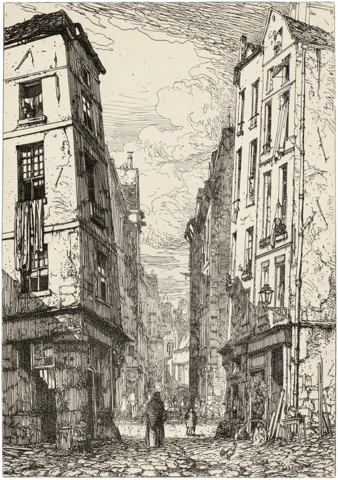
Rue des Marmousets, Paris
Francois Antoine Maxime Lalanne (French, 1827 - 1886)
Etching, 1862
Francois Antoine Maxime Lalanne (French, 1827 - 1886)
Etching, 1862
This is the best known etching of Maxime Lalanne, a French artist active in the latter part of the 19th Century. It shows the Rue des Marmousets, a now forgotten byway on the Rue de La Cite in the heart of Medieval Paris; and a street notorious for a gruesome crime involving murder, dismemberment, and cannibalism attributed to a pasrty chef and a barber. The scene is noteworthy for its fidelity to how Paris must have appeared during the time of Victor Hugo - this is the Paris of Quasimodo, and not of Haussmann.

Lalanne's linework is precise - his work exemplifies the Gallic devotion to reason and intellectual clarity, and he omits nothing, not even bed linens hung out to dry from an upper story window. Paris at the time of the Commune was a warren of winding narrow streets, which made the city unpleasant, unsanitary, and ungovernable. The Paris we see today is the result of many decades of civic renovation, the object of which was the elimination of streets such as this one, which was demolished in 1867 to make way for additions to the Hospital Hotel-Dieu.

Paris' industrial slums were no better or worse than those of other 19th Century cities, but were every bit as bad. Lalanne makes sure we see it all, with no detail left out, including the brave rooster in the FG, strutting proudly about despite being very likely destined for the cookpot.

